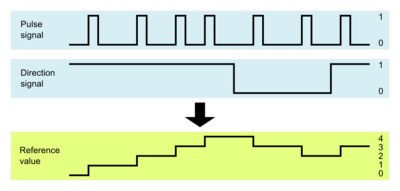Difference between revisions of "Pulse and direction"
From Granite Devices Knowledge Wiki
| [checked revision] | [checked revision] |
| Line 1: | Line 1: | ||
[[File:Pulse and direction wiki.png|thumb|Pulse and direction signals|400px]] | [[File:Pulse and direction wiki.png|thumb|Pulse and direction signals|400px]] | ||
| − | '''Pulse and direction''', '''step and direction''' or '''pulse train''' refers to digital signaling type used in position control. Pulse & dir is famous from stepping motor drives but it also can be used in many servo drives as position or velocity [[ | + | '''Pulse and direction''', '''step and direction''' or '''pulse train''' refers to digital signaling type used in position control. Pulse & dir is famous from stepping motor drives but it also can be used in many servo drives as position or velocity [[setpoint signal]]. |
==Principle== | ==Principle== | ||
Pulse & dir contains two digital signal lines: | Pulse & dir contains two digital signal lines: | ||
Revision as of 21:23, 24 June 2013
Pulse and direction, step and direction or pulse train refers to digital signaling type used in position control. Pulse & dir is famous from stepping motor drives but it also can be used in many servo drives as position or velocity setpoint signal.
Principle
Pulse & dir contains two digital signal lines:
- Pulse - a signal that will control motion distance & speed
- Direction - a signal that will control direction of motion
Pulse has constant distance increment, i.e. 1/1000 of revolution. So to rotate motor one revolution it takes 1000 pulses. To rotate in reverse direction, direction signal state is changed.
